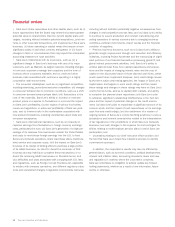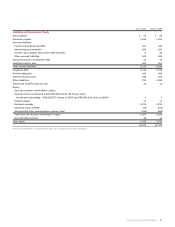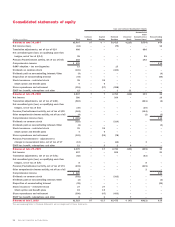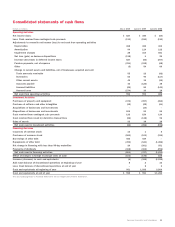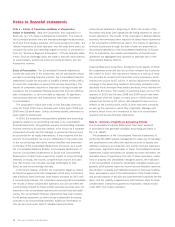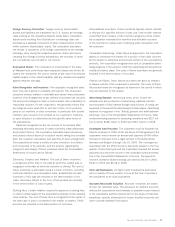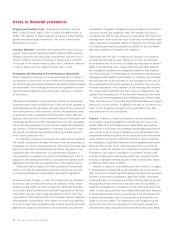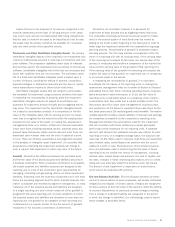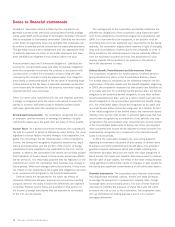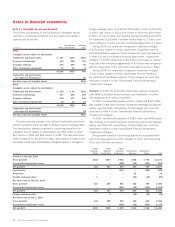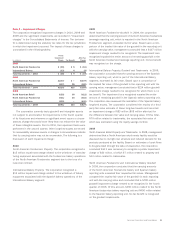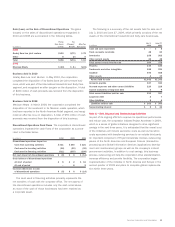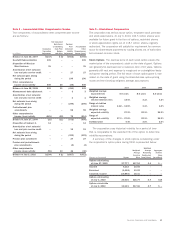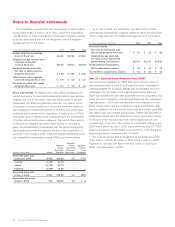Sara Lee 2010 Annual Report Download - page 62
Download and view the complete annual report
Please find page 62 of the 2010 Sara Lee annual report below. You can navigate through the pages in the report by either clicking on the pages listed below, or by using the keyword search tool below to find specific information within the annual report.Notes to financial statements
Severance
Severance actions initiated by the corporation are
generally covered under previously communicated benefit arrange-
ments under GAAP, which provides for termination benefits in the event
that an employee is involuntarily terminated. Liabilities are recorded
under these arrangements when it is probable that employees will
be entitled to benefits and the amount can be reasonably estimated.
This generally occurs when management with the appropriate level
of authority approves an action to terminate employees who have
been identified and targeted for termination within one year.
Noncancelable Lease and Contractual Obligations
Liabilities are
incurred for noncancelable lease and other contractual obligations
when the corporation terminates the contract in accordance with
contract terms or when the corporation ceases using the right
conveyed by the contract or exits the leased space. The charge for
these items is determined based on the fair value of remaining lease
rentals reduced by the fair value of estimated sublease rentals that
could reasonably be obtained for the property, estimated using an
expected present value technique.
Other
For other costs associated with exit and disposal activities,
a charge is recognized at its fair value in the period in which the
liability is incurred, estimated using an expected present value
technique, generally when the services are rendered.
Stock-Based Compensation The corporation recognizes the cost
of employee services received in exchange for awards of equity
instruments based upon the grant date fair value of those awards.
Income Taxes As a global commercial enterprise, the corporation’s
tax rate from period to period is affected by many factors. The most
significant of these factors includes changes in tax legislation, the
global mix of earnings, the tax characteristics of the corporation’s
income, the timing and recognition of goodwill impairments, acqui -
sitions and dispositions and the portion of the income of foreign
subsidiaries that is expected to be repatriated to the U.S. and be
taxable. In addition, the corporation’s tax returns are routinely audited
and finalization of issues raised in these audits sometimes affects
the tax provision. It is reasonably possible that tax legislation in the
jurisdictions in which the corporation does business may change in
future periods. While such changes cannot be predicted, if they occur,
the impact on the corporation’s tax assets and obligations will need
to be measured and recognized in the financial statements.
Deferred taxes are recognized for the future tax effects of
temporary differences between financial and income tax reporting
using tax rates for the years in which the differences are expected
to reverse. Federal income taxes are provided on that portion of
the income of foreign subsidiaries that are expected to be remitted
to the U.S. and be taxable.
The management of the corporation periodically estimates the
probable tax obligations of the corporation using historical experi-
ence in tax jurisdictions and informed judgments in accordance with
GAAP. For a tax benefit to be recognized, a tax position must be
more-likely-than-not to be sustained upon examination by the taxing
authority. The corporation adjusts these reserves in light of changing
facts and circumstances; however, due to the complexity of some of
these situations, the ultimate payment may be materially different
from the estimated recorded amounts. Any adjustment to a tax
reserve impacts the corporation’s tax expense in the period in
which the adjustment is made.
Defined Benefit, Postretirement and Life-Insurance Plans
The corporation recognizes the funded status of defined pension
and postretirement plans in the Consolidated Balance Sheet.
The funded status is measured as the difference between the fair
market value of the plan assets and the benefit obligation. Beginning
in 2009, the corporation measures its plan assets and liabilities as
of its fiscal year end. For a defined benefit pension plan, the benefit
obligation is the projected benefit obligation; for any other defined
benefit postretirement plan, such as a retiree health care plan, the
benefit obligation is the accumulated postretirement benefit obliga-
tion. Any overfunded status should be recognized as an asset and
any underfunded status should be recognized as a liability. As part
of the initial recognition of the funded status, any transitional asset/
(liability), prior service cost (credit) or actuarial (gain)/loss that had
not yet been recognized as a component of net periodic cost was
recognized in the accumulated other comprehensive income section
of the Consolidated Statements of Equity, net of tax. Accumulated
other comprehensive income will be adjusted as these amounts are
subsequently recognized as a component of net periodic benefit
costs in future periods.
In 2010 the corporation adopted new accounting guidance
regarding an employer’s disclosure of plan assets of defined bene-
fit pension and other postretirement benefit plans. The amended
guidance requires disclosures about plan assets including how
investment allocation decisions are made, the major categories of
plans assets, the inputs and valuation techniques used to measure
the fair value of plan assets, the effect of fair value measurements
using significant unobservable inputs on changes in plan assets for
the period and significant concentrations of risk within plan assets.
Financial Instruments The corporation uses financial instruments,
including forward exchange, options, futures and swap contracts,
to manage its exposures to movements in interest rates, foreign
exchange rates and commodity prices. The use of these financial
instruments modifies the exposure of these risks with the intent
to reduce the risk or cost to the corporation. The corporation does
not use derivatives for trading purposes and is not a party to
leveraged derivatives.
60 Sara Lee Corporation and Subsidiaries


